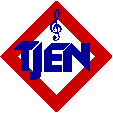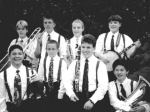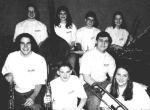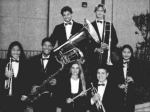 |
 |
    |
The music examined in this Traditional Jazz Curriculum Kit is frequently misunderstood, and even knowledgeable fans, collectors and musicians disagree on terminology and stylistic divisions.
Towards a Definition of Traditional Jazz Before dividing this pie into logical pieces, we should describe the pie itself. What is "traditional jazz"? What are the common denominators that define it? In my view, "traditional jazz" in the proper sense of the term is jazz which exhibits all or most of the following characteristics: 1) Wind instruments playing polyphonically 2) Easily discernible chord patterns 3) 2/4 or 4/4 meter 4) Instrumentation approximating the following:
5) Pre-bop harmonies and phrasing (the earlier the musical vocabulary employed, the greater the compliance to this part of our definition) The single most distinguishing characteristic of traditional jazz is the first element above--the wind instruments playing polyphonically (a New Orleans tradition). This means that each is playing a different melodic line simultaneously. Most traditional jazz displays this characteristic. A performance that lacks this characteristic (either because there is a single wind instrument, or because the wind instruments are scored in "tutti") might still be considered "traditional jazz", depending on the degree to which it meets the other criteria, especially #4 and #5. Using the five criteria above (remember, it's "all or most") as the broad definition of the genre, we can break that genre into a number of distinct stylistic approaches. While most traditional jazz groups blend these stylistic approaches to arrive at their own sound, the divisions below are the primary stylistic touchstones from which they proceed. Any and all of these styles may include vocals. All are still performed today. Note: The artist/group recorded output cited for each style contains some of the earliest and most definitive recorded instances of that style, though it may very well contain non-applicable recordings as well.
New Orleans Styles The New Orleans styles of jazz are the original source of the key characteristics of traditional jazz.
Brass Band Style: Instrumentation (generally): Augmented. Two or more trumpets with some combination of clarinets, trombones, saxophones, and sousaphones, with separate snare and bass drum. Sometimes alto or baritone horns as well. Repertoire: Marches, dirges, pop tunes, spirituals/hymns. Style: Free, loose, improvised. Drummers maintain a swinging, propulsive march-like cadence with an emphasis on beat four of every other measure. Drums continue between tunes, with "roll-offs" announcing each tune. Bass drummer often adds light ringing cymbal on the offbeats. Exaggerated mournfulness for dirges, exaggerated joyousness for uptempo. Recorded examples: Bunk's Brass Band (1945); Eureka Brass Band (1951-70); Dejan's Olympia Brass Band (1962-90s).
Classic New Orleans Style (aka "downtown" New Orleans style): Instrumentation (generally): One or two cornets/trumpets; clarinet or soprano sax; trombone; sometimes one or two tenor/alto saxes; piano; banjo (sometimes guitar); tuba (sometimes string bass, or no bass at all); sometimes drums or washboard--or a subset of the above. Repertoire: Multithemed jazz compositions, blues, rags, pop tunes. Style: "Hot", emotional, ensemble-oriented, often thick texture. Cornet/clarinet use heavy vibrato. Clarinet has thick, woody tone. Cornet often uses straight and/or plunger mute, and makes use of rips, growls, halftones and shakes. Trombone alternates "smeary" fills and staccato punctuations. Phrasing is on-the-beat. Piano/banjo rhythm is generally straight plunk-plunk-plunk-plunk. Drums, if used, are subdued, using choked cymbal, woodblock, light snare. Performances are usually quite structured, and some horn scoring may be present. "Double endings" (two added measures of the tonic chord) and breaks are common. Recorded examples: King Oliver's Creole Jazz Band (1923); New Orleans Rhythm Kings (1922-5); Clarence Williams small groups (1923-35); Louis Armstrong's Hot Five/Seven (1925-8); Celestin's Original Tuxedo Jazz Orchestra (1925-8); Jelly Roll Morton's Red Hot Peppers (1926-30); Johnny Dodds (1927-9); Jimmie Noone's Apex Club Orchestra (1928-30).
New Orleans Revival Style (aka "uptown" New Orleans style): The word "revival" refers to the renewed interest in traditional jazz in the 40s. There is disagreement as to whether this style evolved (or "devolved") from the Classic New Orleans Style in the 40s, or actually predated the Classic New Orleans Style but escaped public notice until the 40s. Instrumentation (generally): Trumpet/cornet; clarinet; trombone; occasionally alto (or tenor) sax; often piano; banjo; bass (occasionally tuba); drums. Repertoire: Pop tunes, blues, marches, spirituals, rags; occasionally also multithemed jazz compositions. Style: Spontaneous (unstructured), ragged, soulful, emotional, often laid-back. Intonation and technical execution are de-emphasized, while conveying an emotional message is everything. Trumpet toys with the beat, sticks fairly close to the lead line; heavy vibrato optional. Some use of derby mute, occasionally harmon (stem in). Clarinet tone as in Classic New Orleans style, but phrasing is less on-the-beat. Albert system clarinets are often used. Clarinet arpeggios are common. Trombone plays "smeary" fills. Rhythm is steady four. Bass is often "slapped". Drums concentrate on snare, especially propulsive press rolls (bzzzzip, bzzzzip), filling the end of eight-bar phrases with tom, woodblock and/or rims. Ride cymbal used sparingly. High ratio of ensemble-to-solos. Horn solos are often accompanied by the other horns, and sometimes consist of an instrument momentarily rising to prominence within the ensemble. Recorded examples: Bunk Johnson (1942-6); George Lewis (1943-65); Kid Ory(1944-61); Kid Thomas Valentine (1951-83); Preservation Hall Jazz Band (1961-90s).
Early Derivative Styles Early "Dixieland" Style: Instrumentation (generally): Cornet/trumpet; clarinet; trombone; sometimes sax (usually alto); piano; banjo (optional); tuba or bass sax (optional); drums. Repertoire: Multithemed jazz compositions, pop tunes. Style: Highly structured performances. A somewhat polished sound. Heavily syncopated (ragtime-like) rhythm. Brisk tempos are common. Emphasis on ensemble choruses, often played repetitively with little variation. Heavy use of "breaks". Horns often phrase in a rhythmically stilted manner. Clarinet is sometimes high and shrill. Drums used sparingly if at all, often being limited to cymbal crash punctuations. Performances often end with silent beats 4 and 1 followed by ensemble "doo-dop" tag on beats 2 and 3. Recorded examples: Original Dixieland Jazz Band (1917-22); Louisiana Five (1918-19); Ted Lewis Jazz Band (1919-24); Original Memphis Five (1922-31); Original Indiana Five (1923-8).
New York Style: Instrumentation (generally): Cornet/trumpet; clarinet; trombone; sometimes sax (tenor or alto); sometimes violin; piano; banjo or guitar; tuba, bass sax or string bass; drums. Repertoire: Pop tunes, multithemed jazz compositions. Style: Highly structured performances, usually featuring intricate arrangements. Very polished sound. Smooth syncopated rhythmic feel. "Straight-eighth" phrasing by the horns but sometimes with a softened attack. Horn soloists often jump wide intervals. Mutes are seldom used. Drum work frequently includes heavy use of choked ("spanked") cymbal. Ensemble and solos featured equally. Arrangements and solos sometimes include the use of whole tones. Endings sometimes employ the "doo-dop" tag. Recorded examples: The Wolverines (1924); University Six (1925-28); Red Nichols and his Five Pennies (1926-7); Miff Mole's Molers (1927); Bix Beiderbecke and his Gang (1927-8).
Chicago Styles Chicago Style is generally thought of as a single style, yet the early recordings in this style are quite different from the later, more familiar Chicago Style. The early Chicago Style was developed and recorded in Chicago, while the later Chicago Style was developed largely in New York by former Chicagoans (many of the same players).
Early Chicago Style: Instrumentation (generally): Trumpet/cornet; clarinet; tenor sax; sometimes trombone; piano; banjo or guitar; tuba or bass; drums. Repertoire: Pop tunes. Style: High-energy. Busy, boisterous ensemble, often with sudden climaxes and anticlimaxes (builds to a crash on beat 4 at the end of a phrase, then the bottom drops out). Performances open and close with ensemble (sometimes partly scored), with succession of solos in between. Ensemble intros are common. 4-beat feel, occasionally shifting to 2-beat. Mutes are seldom used. Punchy, on-the-beat phrasing. Drumming is somewhat busy, often employing an eighth-note feel with fills at the end of phrases. Endings include the "double ending" and the "doo-dop" tag. Recorded examples: McKenzie and Condon's Chicagoans (1927); Chicago Rhythm Kings/Jungle Kings (1928); Wingy Manone and his Club Royale Orchestra/Hot Dogs (1928-30); The Cellar Boys (1930).
Chicago Style (aka "Nicksieland", a play on "dixieland" that recognizes a New York club called "Nick's" where this style flourished): Instrumentation (generally): Trumpet/cornet; clarinet; trombone; sometimes alto, tenor or baritone sax; piano; often guitar; bass; drums. Repertoire: Pop tunes, multithemed jazz compositions. Style: Generally an unstructured "jam session" approach, though sometimes employing scored passages. Succession-of-solos is the primary emphasis, with most players soloing on each tune. Horns sometimes riff behind soloists. Rhythm is smooth and swing-like; the feel is usually 4/4. Horn players may be driving or laid-back, but phrasing is generally smooth, melodic, and technically proficient. Some use of cup, harmon (stem out) and plunger mutes. Piano comps behind soloists. Drums make use of ride cymbal/hi-hat/brushes, and drum solos are common. Performances typically begin with a 4- or 8-bar intro, often played by the piano, and end with a 4-bar drum tag followed by ensemble repeating the final 4 or 8 bars; or, sometimes, a cowbell "ding-ding" on beats 4 and 1 followed by ensemble "doo-dop" on beats 2 and 3. Recorded examples: Eddie Condon (1933-71); Bobby Hackett small groups (1938-58); Bud Freeman (late 30s-80s); Muggsy Spanier (1939-58); George Wettling (1940-58); Art Hodes (early 40s-80s); Jack Teagarden small groups (1943-62); Wild Bill Davison (1943-80s).
Chicago Style Extensions Swing Style: This style is closely related to the Chicago style. For purposes of "traditional jazz", this category does not include big-band swing, nor does it include the majority of small-band swing. It includes only small-band swing that displays New Orleans characteristics as described below. Instrumentation (generally): Trumpet; clarinet; trombone and/or sax (usually tenor); piano; guitar (usually); bass; drums. Sometimes additional horns. Repertoire: Swing repertoire, pop tunes, multithemed jazz compositions. Style: Swing rhythm is emphasized, with drums using ride cymbal/hi-hat/brushes extensively. Horns use the phrasing and harmonic language of swing. Trumpet/trombone sometimes use cup mute. The approach is either a jam session in a swing style with collective improvisation opening and/or closing the performance; or the horns scored in harmony in a big-band-type arrangement (with space for solos). Riffs are common. Recorded examples: Louis Prima and his New Orleans Gang (1934-39); Fats Waller and his Rhythm (1934-43); Wingy Manone (1934-41); Teddy Wilson small groups (1935-44); Tommy Dorsey's Clambake Seven (1935-8); Frankie Newton (1937-9); Bob Crosby's Bobcats (1937-45).
Mainstream Style: While it may seem like an oxymoron to designate a "mainstream style" within "traditional jazz", there is an approach to jazz performance in which the traditional New Orleans instrumentation and polyphony are present along with elements of post-swing musical vocabulary. Instrumentation (generally): Trumpet/cornet; clarinet; sax (alto/tenor) and/or trombone; piano; sometimes guitar; bass; drums. Horn configurations vary. Repertoire: Early and later pop tunes, early and later jazz compositions. Style: Solo construction and phrasing, and rhythmic feel, are in a "mainstream jazz" style reflecting some postwar jazz developments. Ensemble polyphony is sometimes incidental to the solo efforts. Piano comps using modernish voicings. Drums uses "kicks". Bass uses long sustain. Trumpet/trombone sometimes use cup or stemless harmon mute. Overall sound is smooth, swinging and somewhat contemporary. Performances tend to be long. Recorded examples: Vic Dickenson (1953-4); Red Allen (late 50s); Ruby Braff (late 50s-90s); George Wein (1956-67); Pee Wee Russell (1958-66).
San Francisco Style (aka “West Coast Style”, not to be confused with the “cool” West Coast Style of contemporary jazz in the 1950s) Instrumentation (generally): One or two trumpets/cornets; clarinet or soprano sax; trombone; piano; banjo; tuba; usually drums or washboard--or a subset of the above. Repertoire: Multithemed jazz compositions (including new pieces written for this style), blues, rags; occasionally also pop tunes, hymns/spirituals. Style: Modeled after the Classic New Orleans Style, but a brighter, brassier sound and usually more of a two-beat feel. Deliberate, "swaggering" rhythm. Driving, ripping trumpet; New Orleans-tinged clarinet; gruff trombone; ragtime-style piano; heavy banjo, usually emphasizing 2 and 4; tuba plays 1 and 3, often "leaning into" 1; spare drumming, emphasizing choked cymbal and woodblock. Ensemble is emphasized. "Double endings" are the norm. Recorded examples: Lu Watters' Yerba Buena Jazz Band (1941-50); Turk Murphy (1947-88); Dixieland Rhythm Kings (1948-58); Firehouse Five Plus Two (1949-69); Original Salty Dogs (1962-99).
European "Trad" Style This style originated in Europe, achieving the most prominence in England. While the term "trad jazz" is often used to mean "traditional jazz" in the generic sense, "Trad" is also the word applied to this particular style. Instrumentation (generally): Trumpet/cornet, trombone, clarinet, occasionally sax, piano (optional), banjo, bass, drums. Repertoire: Pop tunes, blues, marches, spirituals/hymns, rags, multithemed jazz compositions. Style: Based on the New Orleans Revival Style, but generally more polished and structured. Rhythm is a steady 4. The banjo/bass combination is the heart of the style. Banjo has a distinctive crisp, ringing sound. Drumming is generally more Chicago- or swing-oriented than New Orleans-oriented. Recorded examples: Dutch Swing College Band (1948-85); Chris Barber small groups (1949-2003); Acker Bilk (1955-63); Kenny Ball (1957-99); Monty Sunshine (1961-97).
A Few Stylistic Byways The Commercial Element: Over the years a number of artists/groups have achieved success by infusing traditional jazz with commercial elements designed for mass appeal. This approach is commonly based on Chicago or Swing Style, but is sometimes based on San Francisco or European "Trad" Style. The resulting performances may be highly arranged and stylized, and may be unusually loud or "showy". Phrasings are sometimes exaggerated for effect. Soloists may display great technical skill. The recorded examples include examples of a variety of traditional jazz styles, having in common a certain commercial element. (This observation is in no way intended as a value judgment.) An offshoot of the "commercial" approach is the combination of traditional jazz with other genres of popular music. Probably the best-known example of this is the "folk dixie" of the 60s, as popularized by the Village Stompers (1963-6) and others. This approach rode the crest of the folk music craze by playing folk and pop tunes in a traditional jazz style, with the inclusion of lead choruses by the banjo in a "single-string" style. Other groups have combined traditional jazz with country, classical, "the twist", disco, polka, rock, the samba, etc.; many recorded examples exist. Recorded examples: Louis Armstrong's All Stars (1947-68); Firehouse Five Plus Two (1949-69); Al Hirt (1955-67); Dukes of Dixieland (1956-60); Pete Fountain (1956-90); Kings of Dixieland (1959-62). "Skiffle" Music: An idiom overlapping traditional jazz is "skiffle" (aka "jug band" or "spasm band") music. The word "skiffle" implies an informal blues or jazz jam session in which vocals feature prominently and homemade instruments are used. Wind instruments may or may not be present. Some skiffle performances feature wind instruments playing polyphonically, which fits our criteria of traditional jazz. Instruments typically found in a "skiffle band" include (in any combination) guitar, banjo, mandolin, "gutbucket" (washtub bass), washboard, jug, harmonica, kazoo, cornet, fiddle, clarinet, musical saw, comb, etc.
Recorded examples: Dixieland Jug Blowers (1926-7); Five Harmaniacs (1926-7); Tub Jug Washboard Band (1928); State Street Ramblers (1931); Alabama Jug Band (1934).
Early Piano Styles: The music described in this guide is played by groups containing wind instruments. Woven throughout these ensemble styles are various piano styles that are also performed in a solo setting. We might separate these piano styles into major categories as well, thus:
There are other categories that could be named here, and several of those named can be further divided into substyles. Ragtime is generally not considered a jazz piano style per se, but it is found in some "traditional jazz" settings (most notably San Francisco Style).
What About "Hot Dance" Style? Absent from the above descriptions of the styles of traditional jazz is the dominant popular music of the late 1920s and early 1930s: "hot dance". This music was performed by pre-swing "big bands" of about 9-12 pieces. It was highly arranged, using syncopated rhythms and, to varying degrees, "hot" (i.e. jazz) solos. Typical instrumentation included two trumpets, trombone, three saxes, violin, piano, banjo, tuba, and drums. While it is related to the 1920s styles of traditional jazz, this music's instrumentation and approach are markedly different. Instead of a small number of horns playing polyphonically, "hot dance" uses five or more horns scored as sections playing in tutti. It must be noted, however, that some fairly large bands mixed sectional tutti passages with polyphonic passages in a single performance.
Why Draw These Lines at All? There are many who sneer at any analysis of traditional jazz (or any other music), stating that it is unimportant--or even destructive--to recognize such categories as the above. I believe that the better we understand an art form's inner workings, and the more we share that knowledge, the better that art form can be appreciated. Still, such categorization leads to labeling, which can be a dangerous process. Labels must be used carefully and responsibly. If we use them carelessly, the result can be that something we label is assumed, by association, to have a certain characteristic that it does not in fact have, or the reverse. The stylistic categories set out above are more safely applied to individual performances than to artists. We must be wary of "typecasting" artists (and such is not the intent in citing recorded examples herein). And we must be careful to qualify our stylistic labels as we use them. Finally, it bears repeating that relatively few traditional jazz performances are "pure" manifestations of any one style above. Mixing and matching various stylistic elements is the norm--that is, after all, the creative process. Traditional jazz is a kaleidoscope of styles, one that is still being turned to create new colors. � 2014 David F. Robinson, Jr. |
|